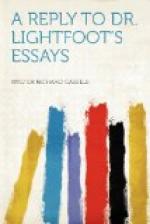Dr. Lightfoot supposes that I had overlooked the testimony of the Doctrine of Addai, an apocryphal Syriac work, published in 1876 by Dr. Phillips after Supernatural Religion was written. I did not overlook it, but I considered it of too little critical value to require much notice in later editions of the work. The Doctrine of Addai is conjecturally dated by Dr. Lightfoot about the middle of the third century, [147:4] and it might with greater certainty be placed much later. The passage to which he points is one in which it is said that the new converts meet together to hear, along with the Old Testament, “the New of the Diatessaron.” This is assumed to be Tatian’s “Harmony of the Gospels,” and I shall not further argue the point; but does it bring us any nearer to a certain understanding of its character and contents?
The next witness, taking them in the order in which Dr. Lightfoot cites them, is Dionysius Bar-Salibi, who flourished in the last years of the twelfth century. In his commentary on the Gospels he writes:—
“Tatian, the disciple of Justin, the philosopher and martyr, selected and patched together from the four Gospels and constructed a gospel, which he called Diatessaron—that is, Miscellanies. On this work Mar Ephraem wrote an exposition; and its commencement was—In the beginning was the Word. Elias of Salamia, who is also called Aphthonius, constructed a gospel after the likeness of the Diatessaron of Ammonius, mentioned by Eusebius in his prologue to the Canons which he made for the Gospel. Elias sought for that Diatessaron and could not find it, and in consequence constructed this after its likeness. And the said Elias finds fault with several things in the Canons of Eusebius, and points out errors in them, and rightly. But this copy (work) which Elias composed is not often met with.” [148:1]
This information regarding Ephraem—who died about A.D. 373—be it remembered, is given by a writer of the twelfth century, and but for this we should not have known from any ancient independent source that Ephraem had composed a commentary at all, supposing that he did so. It is important to note, however, that a second Diatessaron, prepared by Ammonius, is here mentioned, and that it was also described by Eusebius in his Epistle to Carpianus, and further that Bar-Salibi speaks of a third, composed on the same lines by Elias. Dr. Lightfoot disposes of the Diatessaron of Ammonius in a very decided way. He says:
“It was quite different in its character from the Diatessaron of Tatian. The Diatessaron of Tatian was a patchwork of the four Gospels, commencing with the preface of St. John. The work of Ammonius took the Gospel of St. Matthew as its standard, preserving its continuity, and placed side by side with it parallel passages from the other Gospels. The principle of the one was amalgamation;




